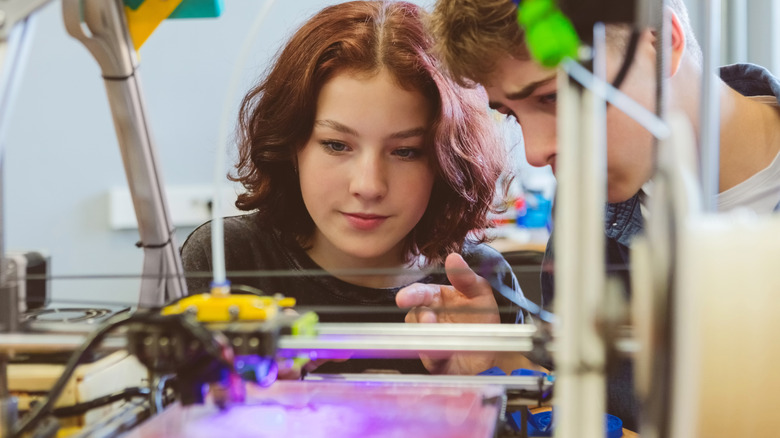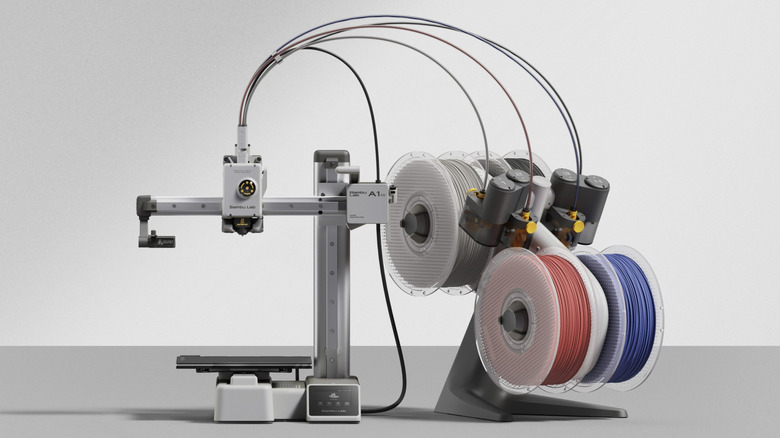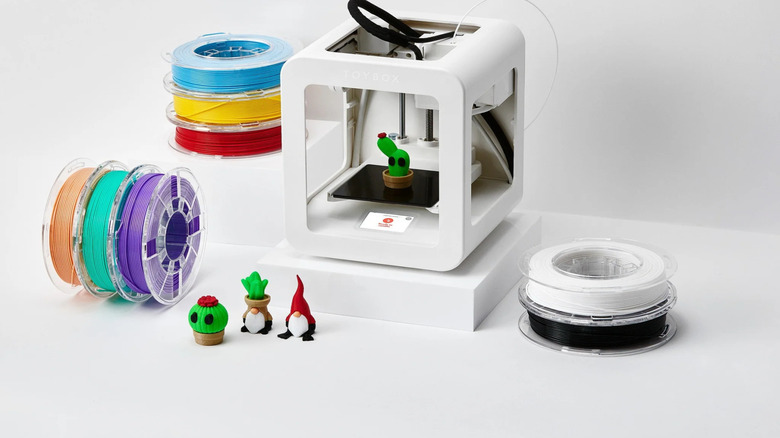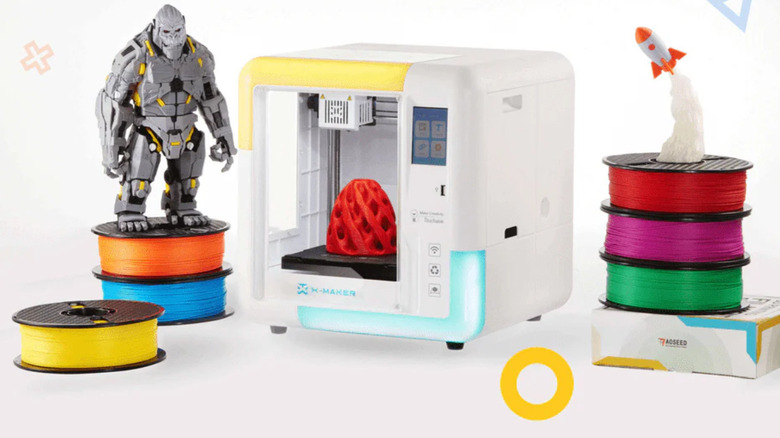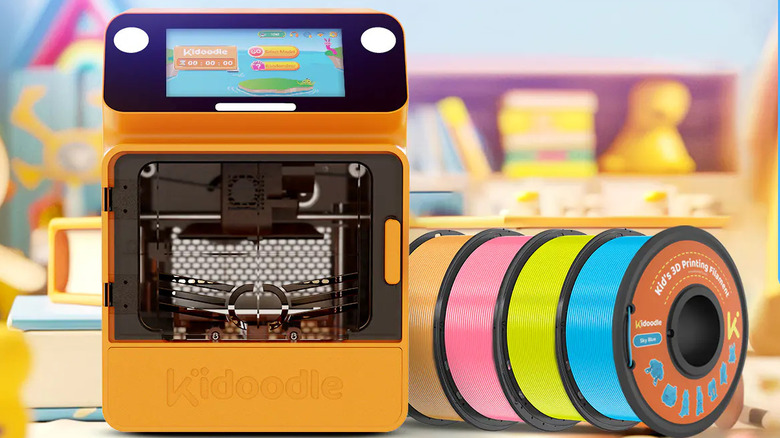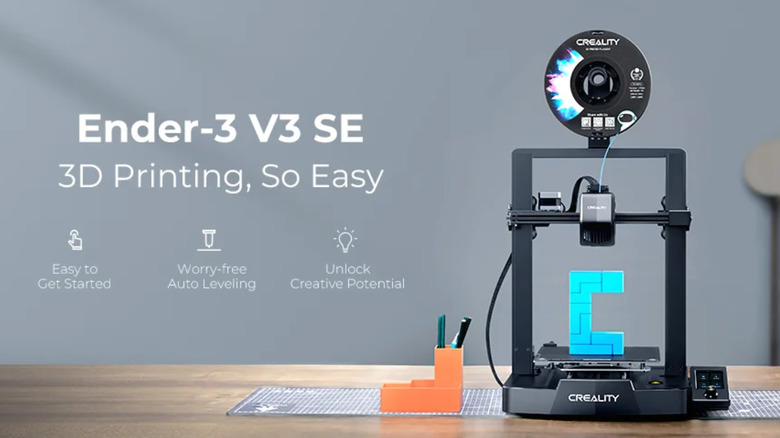5 Affordable 3D Printers For Kids And Teens
There's nothing parents fear more than raising an iPad kid. With technology more accessible (and distracting) than ever before, many parents are on the lookout for new ways to encourage their child's creative curiosity. While it feels like the days of building forts and causing neighborhood mischief are a thing of the past, the next generation has many new and exciting creative outlets available. One of the most innovative is 3D printing, which has steadily evolved into an accessible and affordable tool for kids and teens, with several brands catering to younger users.
When buying a 3D printer for your kids or teens, it's important to consider factors like safety, ease of use, durability, and price. Typically, filament-based printers are more user-friendly than their resin counterparts. They are also cheaper to reload, and produce more durable creations. As such, printers using common filaments like PLA (polylactic acid) and PETG (Poly-Ethylne Terephthalate Glycol) are usually easier to set up for kids. Another bonus is that these nontoxic materials are safe for children.
In terms of safety, smaller children can benefit from additional features from 3D printers like enclosed print areas and automatic temperature-cooling. For teens, it is important to prioritize printers that can produce larger, more complex projects as they grow more comfortable with the technology.
With that in mind, let's take a look at some popular filament-based printers, and see which printer is right for you.
Bambu Lab A1 Mini: An easy to use, premium printer for your teenager
One of the best printers for adolescents is Bambu Lab's A1 Mini. A smaller version of its popular A1, the A1 Mini comes pre-assembled and tuned, meaning less than half an hour separates buyers between unboxing and its first print. The A1 Mini is a useful tool for teens looking for a printer that can handle multiple colors and filament types without the nuisance of complicated calibration processes.
The A1 Mini arrives auto-calibrated, meaning your teenager won't need to worry about issues like bed level, nozzle pressure, belt tension, or vibration resonance. It also comes with flow rate and vibration compensation features, ensuring consistent print quality. With a max printing speed of 500 mm/s, an intuitive touchscreen, and 1-click printing applications, the A1 Mini delivers fast, high-quality prints with a minimum learning curve.
For parents worried about the durability of their A1 Mini, Bambu Lab touts that its all-metal frame and bearings guarantee longevity and performance. Maintenance is also a breeze, as its nozzle and filaments are easily reloaded. One thing to note: Buyers who want to print more than one color at a time must spring for the A1 Mini Combo, which includes the AMS (automatic material system) lite add-on. Both models support a range of filament types, including PLA, PETG, TPU, PVA. The AI Mini is great for teens looking for an advanced printing experience with a shorter learning curve. Although pricier than most others on this list, it is one of the best 3D printers on the market for a reason.
Toybox Alpha Two: A mini toy factory for kids
If you're looking to buy a 3D printer for a younger child, the Toybox Alpha Two is a fantastic option that won't break the bank. First introduced on season 10 of "Shark Tank," every aspect of the Toybox's one-button printer experience is geared towards children. With tool-less setup, child-friendly instructions, and over 7,000 customizable designs at their disposal, the Alpha Two is a great option for any child looking to make their own toy collection.
A major benefit of the Toybox is its durability and safety features. With a sturdy "injection-molded" frame, rounded edges, and enclosed printer space, this printer ensures a lasting, safe experience. Another positive is that its filament is a non-toxic, corn-based bio-plastic that comes in 14 colors and costs $11 per half-pound roll. The printer's easy-peel base is also great for children.
One downside with the Alpha Two is that its printing speed (75 mm/s) is slower than the others on this list. Also, its 75x80x90 mm print tray does not accommodate larger prints. For parents who want to spring for a larger printer, Toybox also offers the Toybox Comet, which can print projects seven times larger.
In either case, the Toybox is not for thin wallets. With a base package that retails at $459, the Alpha Two is a steeply priced outlet for your child's creative needs, though it has gone on sale for $289.
AOSEED X-Maker and X-Maker Joy: Premium printers with kids in mind
For parents looking to invest in a 3D printer, the AOSEED X-Maker offers a premium experience with a price to match. Retailing at $489, the AOSEED X Maker is an enclosed 3D printer that is easy for beginners, but capable of scaling up as your child becomes more advanced.
Designed for creators aged 9-16 years old, the X Maker is a user-friendly printer equipped with several features that elevate it above its competition, including voice activation, 0.1/0.05mm precision printing, and wireless one-click printing. As well, the gamified 3D printing application software enables users to sketch designs, personalize graphics, and build new prints via virtual blocks in a fun, simple fashion. Another advantage is that the X-Maker comes fully assembled and calibrated, meaning your teen can print one of its 1,500 templates right out of the box.
If you are looking to get the AOSEED experience at a lower price point, the company offers the X-Maker Joy: A smaller, simpler printer with fewer customization features, no touch screen, and PLA-only filaments for $200 cheaper. Designed for beginners ages 4-9 years old, it is unlikely that the X-Maker Joy will support more advanced projects. However, one major advantage is that this compact printer retains the same print speed (120 to 300 mm/s) and layer resolution (50 to 300 microns) as its larger counterpart, making it a great option for buyers looking for a premium printer at a reasonable price.
Kidoodle MiniBox A1: Safe, easy, cost effective start to the printing journey
For parents looking for a test drive in the 3D printing market, the Kidoodle Minibox A1 is a cheap, safe, and easy-to-use option. Designed for young children, the Kidoodle is built with safety in mind. Its enclosed printing area includes child lock, automatic pause, and temperature-lowering features to prevent your kid from touching hot or moving surfaces. The lack of a hotbed is an additional safety precaution, although it requires users to apply a glue stick to the base before printing. The Minibox's PLA filaments are fashioned from eco-safe materials and come in eight colors.
In addition to its safety features, the Kidoodle is setup-free and can function without an additional application. It comes with a touch screen designed specifically for children, and includes a variety of toy models. With a print speed of 600mms/s, the Minibox A1 can deliver a Benchy model in just 21 minutes, making it a quick and efficient way for your child to produce their creations. For parents looking to turn their child's playtime into a learning experience, Kidoodle touts its product as a STEM tool that provides a hands-on creation experience that "integrates science, technology, engineering, and math concepts."
What separates Kidoodle from other child-friendly printers is its price point. At $66.60, the Kidoodle allows kids to dip their toes into 3D printing without a major financial commitment. With that being said, parents looking to start their kids on the Kidoodle may have to wait, as its Minibox A1 model is currently sold out.
Creality Ender-3 V3 SE: an inexpensive printer with high level features
For teens who've already cut their teeth in the 3D printing world — or who are technically savvy enough to work through a learning curve — the Creality Ender-3 V3 SE is a strong option with an almost unbeatable price point, coming in as low as $189. Although it requires some assembly, Creality states that only twenty minutes separate its users from unboxing to its first printing.
What separates this Creality model from the others at its price point is the number of automated features that enable beginners to quickly and easily handle their new printer. With auto filament reloading, CR Touch sensor auto-leveling, auto Z offset, and a straightforward user interface, the Creality delivers a strong user experience without the need for extra calibration. The printer also reaches an exceptional print speed, achieving up to 250 mm/s while maintaining an accuracy of 0.1 mm.
Its "Sprite" extruder also enables users to utilize a variety of filaments, including PETG, PLA, and flexible TPU. To maximize creativity, the Creality Ender-3 V3 SE includes access to the slicing application Creality Print and the all-inclusive platform Creality Cloud, where customers can access unlimited models. While not ideal for young children, the Creality Ender 3 V3 SE is a strong option for those looking to buy their teenager a quality printer, without breaking the bank.
